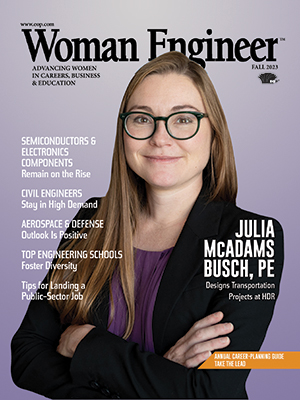| |

Woman Engineer Magazine, launched in 1979, is a career-guidance and recruitment magazine offered at no charge to qualified women engineering, computer science and information technology students & professionals seeking employment and advancement opportunities in their careers.
This magazine reaches students and professional women engineers nationwide at their home addresses, colleges and universities, and chapters of student and professional organizations.
If you are a woman engineering student or professional, Woman Engineer is available to you FREE!

|
|
 WOMAN ENGINEER
WOMAN ENGINEER
» Featured Articles
» Subscription Information
» Reader Survey
» Companies Actively Recruiting

Race Matters When
Recruiting Women
Attempts to recruit and retain more women in undergraduate engineering programs often lump all female students into a single group. At best, minority women as a group may receive special attention. But a study of female engineering students’ perceived challenges finds significant differences between African American, Hispanic, Native American, Asian-American, and white women. The findings by researchers at University of Washington (UW) could help institutions better retain particular underrepresented groups of students.
“What we’re finding is these women’s experiences are different, which is why grouping all women together doesn’t make sense,” says co-author Elizabeth Litzler, research director at the UW’s center for workforce development. The study used data collected in 2008 by the Project to Assess Climate in Engineering survey, conducted by UW researchers and funded by the Alfred P. Sloan Foundation. Investigators distributed questionnaires and interviews to undergraduate engineering students at 21 U.S. colleges and universities that were interested in supporting diversity programs. The study received more than 10,500 responses, with higher than average numbers of women and minority students.
The UW researchers looked at the aggregate findings to seek overall trends among the responses. Students were asked about such subjects as teaching, labs, student interactions, personal experiences, and their perceptions of their major.
“We see important trends in our findings,” Litzler states. “For example, Hispanics reported feeling like they were taken less seriously than other students. African Americans, not at all.”
However, African-American women reported higher instances of feeling singled out in the classroom because of their race than Hispanic, Native American, and Asian-American women.
Another significant finding related to female students’ comfort approaching their professors. Many female students said they were uncomfortable approaching professors with questions, but African-American women were significantly less likely to report this as an issue. Native American women were the least likely to approach their professors individually.
“These findings advance our understanding of race and experience of undergraduate engineering education,” Litzler adds. “I don’t think this suggest huge differences. But having a better understanding of where students may be coming from may be able to help us direct them, and give them suggestions that may lead to them staying in engineering.”
The UW investigators also will continue with the larger PACE study. Researchers gave each school a summary of its students’ responses as well as recommendations for interventions that would improve the students’ experiences, such as instituting diversity training for teaching assistants or providing more mentoring opportunities for freshmen women. More than half the schools have since implemented at least three of the suggested interventions.
Students at the UW were not included in the study because it looked only at one-tier schools, where students enroll in an undergraduate engineering program directly from high school. However, the UW and other schools where not all engineering students are admitted in the freshman year could still benefit from the findings.
 » Feedback for the Editor
» Feedback for the Editor
» Request Article Copy
|
|